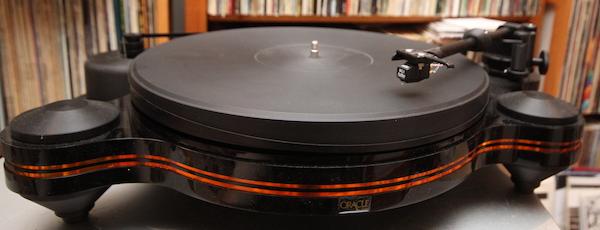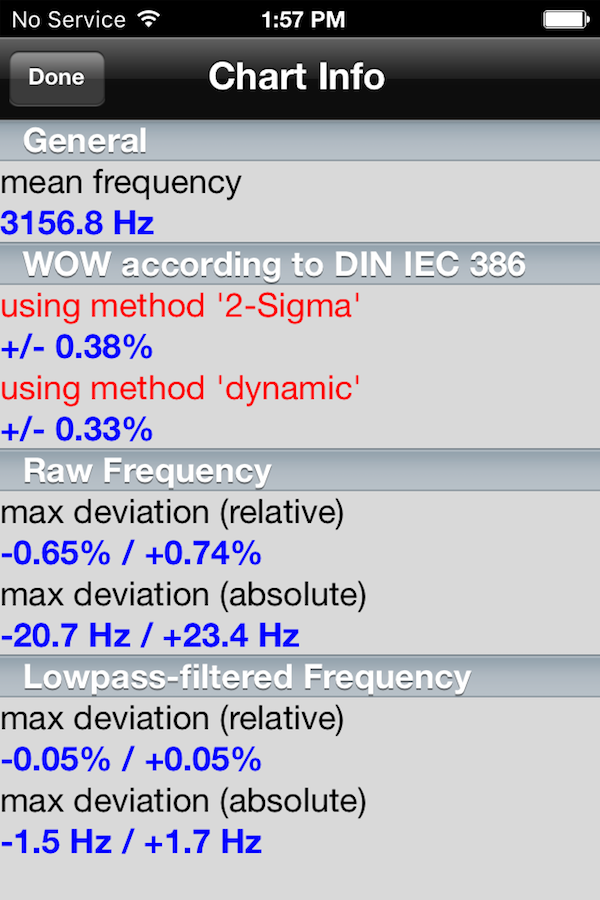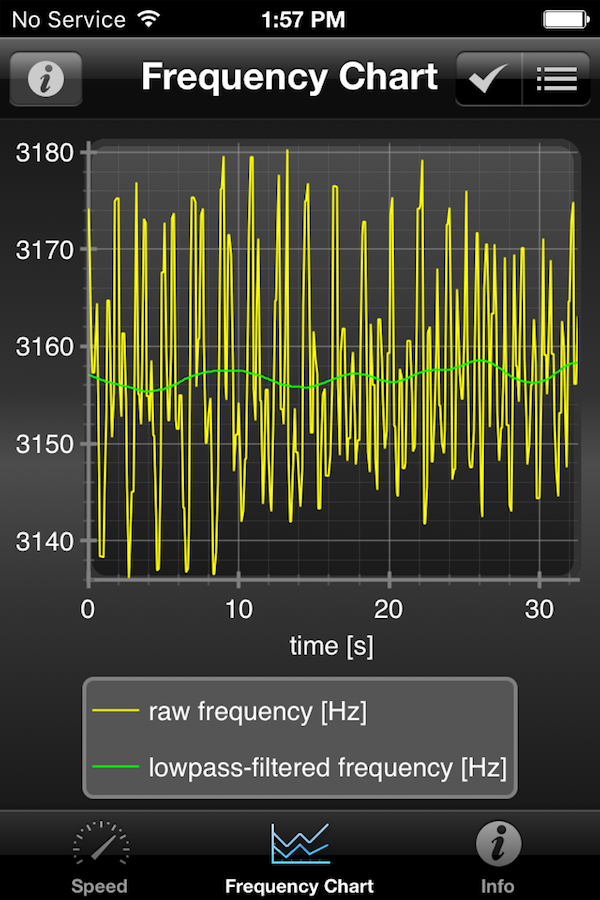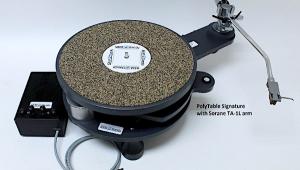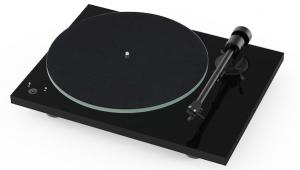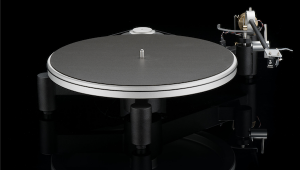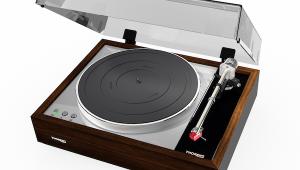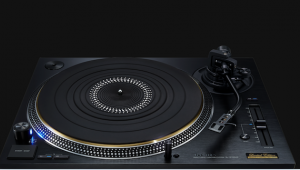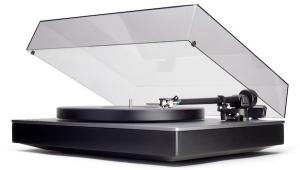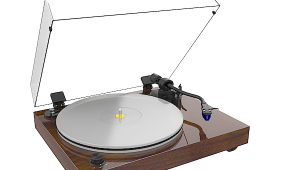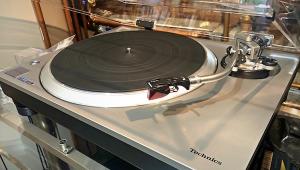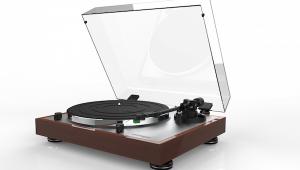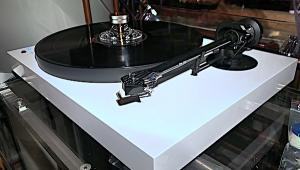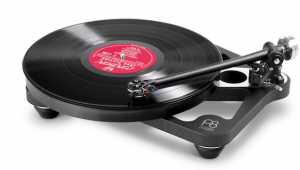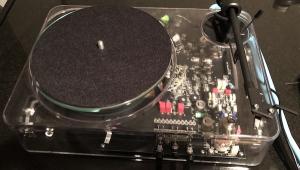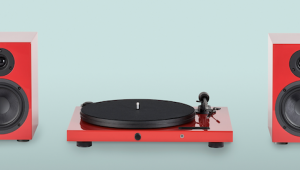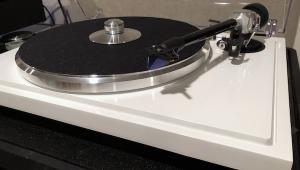Oracle Audio Swings For the Middle Deck With the Origine MkII Turntable
The upgraded version includes a new “wall-wart” powered 16V AC synchronous motor (the original was 24V AC—customers with that motor can get a free upgrade, paying for shipping one way) and a new silicon damped cueing mechanism replacing the original’s “direct action” cueing system (which for original Origine owners can be upgraded for $85). It uses a knob rather than a traditional lever, that you turn to raise and lower the arm.
The Origine comes complete with an Oracle-designed, fully adjustable unipivot pickup arm of Delrin (the housing, which appears to be thin 3D printed layers pressed together) and aluminum (the arm tube?—Oracle doesn’t specify) that has an effective length of 240mm (9.45”) and a pivot to spindle distance of 223mm (8.780”). The design puts the pivot point on the plane of play for added stability. Internal wiring is from Cardas.
The online manual includes excellent instructions for setting overhang, zenith angle, VTA, anti-skating (though the manual repeats the misinformation that skating is caused by centripetal force—it’s not), azimuth and of course VTF. In addition Oracle supplies a mid-tube damping/clamping weight it refers to as “The Olive”, which helps eliminate “unwanted armtube resonances” (are there any “wanted” arm tube resonances?).
Oracle suggests the mid-tube position for higher compliance cartridges and closer to the head shell positioning for lower compliance ones. Sliding the “olive” towards the head shell increases effective mass so a test record would be useful to determine the arm/cartridge resonant frequency and adjust the olive as needed to achieve between 8-12 Hz.
The review sample came pre-fitted and calibrated for an Ortofon 2M Blue ($200). A second pre-fitted and calibrated arm was supplied with an Ortofon MC1 Turbo, a similarly priced high output MC cartridge.
100% designed and built in Canada, the Origine MKII, takes advantage of a few existing Oracle products. The footers are derived from the company’s CD players and the acrylic platter is “inherited” from the more costly Paris MKV turntable (Oracle calls it “acrylic” but to me it appears to be POM or Delrin, which I consider to be a superior platter material). The manual points out that the Origine’s triangular outline resembles the Delphi’s footprint, but that’s pushing it!.
The ‘table’s base is an acrylic sandwich construction with an option to add to the one supplied, more fanciful translucent inserts ($130 each) available in 11 different colors. The sandwich construction is both attractive and functional: the inserts add a level of damping. The more inserts you add the more effective the damping? I don’t know. You can even order an LED light to spotlight the inserts—nothing wrong with a little eye candy!
Drive is via a flat, precision ground rubber belt riding on the acrylic platter’s periphery and a stepped, crowned pulley atop the outboard motor. The steel platter spindle bearing rides in a two bush system that’s a “direct descendent” of the one used in original Delphi turntable. Oracle offers as a $250 option a very nicely manufactured acrylic dustcover.
The Origine MKII’s MSRP is a very reasonable $2350 including either the Ortofon 2M Blue or MC Turbo 1 cartridge set up on the arm and ready to play. Or you can order the ‘table minus cartridge for around $2000.
The supplied Origine MKII came with the optional dust cover as well as two Neon Gold inserts for a total MSRP of $2860. Oracle kindly supplied two arms one fitted with each Ortofon cartridge option.
Set Up
Clearly the idea was to produce a high quality “plug’n’play” turntable, while allowing more sophisticated end-users the ability to set all arm parameters with other cartridges of their choosing (the supplied strobe disc includes the overhang gauge).
After installing the adjustable feet you add the bearing oil to the well from the supplied syringe and then lower the platter’s bearing spindle into it. You then remove the pickup arm’s pivot point protector and lower the arm onto it. Next you carefully connect the arm’s 5 pin wiring harness plug to the RCA output box receptacle. Then you carefully place the anti-skating weight already attached to arm via a thread, over the support hook and you’re set for 1 gram compensation. Supplied stainless steel pins each adding .25g can be inserted into to the anti-skating pod.
Level the platter using the adjustable feet and supplied spirit bubble, then check the pre-calibrated arm’s tracking force and adjust if necessary using the supplled Ortofon VTF gauge.
Finally, position the motor as directed next to the platter and locate the belt around the platter and pulley, making sure that the belt’s rougher side contacts the platter and pulley. Other than plugging in the power supply, and checking the platter speed, which is only marginally adjustable by moving the motor further away or closer to the platter, after plugging in the RCA plugs, you’re ready to play records! Be sure to use the supplied screw on record clamp.
Measured and Noted Performance
Spinning at the correct, consistent speed is job number one for any turntable. For a moderately priced one correct and reasonably consistent speed suffices.
Here are the Platterspeed numbers and chart:
The Origine MKII ran slightly fast, producing 3156.8Hz from the 3150Hz test tone but that’s sufficiently close to correct to not be audible or an issue. In fact, it’s about what Rega’s RP10 produced, though that ‘table was otherwise two to three times more accurate in every other measurement, which is how a turntable costing three times as much should perform! Overall, then, the Origine MKII’s performance was very good and consistent with what should be expected at this price point.
While it’s not necessarily indicative of a turntable’s sonic performance I feel worthwhile doing an impulse “tap test” with the stylus sitting in a record groove on a non-spinning platter. It does give you an indication of the turntable’s isolation. For instance the Bergmann Galder turntable that I recently reviewed for Stereophile was among the best isolated. I could bang on the platform upon which it sat and almost nothing could be heard through the speakers. Of course the base price for that ‘table without arm is $21,900!
Tapping on the Stillpoints rack’s top shelf adjacent to the turntable produced a very loud, lively “pop” (with plenty of low frequency content) through the speakers indicating ineffective isolation from impulse-type noise that might be produced by “footfalls” on springy floors, though it’s difficult to make sweeping generalizations. It’s just something to keep in mind if you’re considering purchasing this turntable. Of course if you place your turntable on a good isolation stand like the Stillpoints, and tap on the rack itself and not the shelf, almost nothing gets through to the speakers!
Surprisingly Robust, Yet Sweet Sound
I used a few MM phono preamps including the Graham Slee Accession (long overdue review coming shortly) and the Lejonklou Gaio that’s been written about but not formally reviewed (long overdue review coming shortly). I also tried various mats, sticking with the thin ones so I didn’t have to fiddle with or consider SRA changes.
I also thought it appropriate to play mostly Canadian artists including Leonard Cohen, Bruce Cockburn, Neil Young, k.d. lang, Joni Mitchell, Diana Krall, Gordon Lightfoot, Daniel Lanois, Glenn Gould and the Anne Bisson Trio. Maybe I omitted your favorite, like Geddy Lee or Drake. Sorry! Can’t please everyone. But these gave me a wide range of artists and sounds, particularly male and female voices.
Whether or not it was related to the “lively” impulse “tap test” the overall tonal balance produced by the Origine MKII with either supplied cartridge using any of the phono preamps was, on bottom, on the sweet, warm side, but with bass that was “tuneful”, reasonably well-controlled, well-extended and not at all excessive or obtrusive.
For instance the kick drum on Bruce Cockburn’s well-recorded Dancing in the Dragon’s Jaw (Millenium BXL1-7747) had good punch, pitch and extension without swamping the higher frequency goings on that include drums, congas, guitars, piano and bass. The general warmth helps produce pleasing stage-depth, yet Cockburn’s voice never turned “chesty”. Image stability and soundstage solidity were both good too.
Diana Krall’s Turn Up the Quiet (Verve B0026480-01) engineered by the great Al Schmitt who’s still got it at 88 (!) (and looks as good as the recordings he engineers sound), was recorded at Capitol to Pro Tools and mastered at The Bakery by Eric Boulanger who now owns and uses Stan Ricker’s lathe. I don’t care if you’re an AAA fanatic (I am), you’ll find the sound here as you like/love it.
On the album closer, Irving Berlin’s “forget the depression” song “Blue Skies”, the core is Krall on piano and vocals, Christian McBride on bass and Russell Malone on guitar. Yes, the Origine MKII places it somewhat on the warm side but the bass is well-articulated center stage and Malone’s hollow bodied electric also placed center stage is well-delineated including when he’s strumming well down in the mix behind. There’s a conga placed back there as well, that’s well-defined and texturally and timbrally believable and Krall’s vocal is spot on with a slight microphone induced pleasing edge. Even United Record Pressing cooperated on this one. I don’t hate them! I just hate bad pressings, which they sometimes produce. This 180g three sided set was pressed flat and quiet with but a few tiny visible but inaudible dimples. Krall gets bad press at audio shows because she’s overplayed but that’s party because she cares about good sound and her records are always well recorded so don’t let show abuse stop you from getting this one unless you’re “Krall-ed out”!
To paraphrase the old Men’s Warehouse TV spot: if you’re a musician “you’ll like what you sound like” through this cartridge/’table combo. It’s particularly free of hollow resonances that sometimes pollute less costly turntables—especially those that manage good bass extension, which the Origine MKII does.
Switching to the Ortofon MC 1Turbo produced a faster, cleaner, more nimble and definitely brighter (but not harsh and/or edgy) sonic picture that to my ears was far superior and better suited to this ‘table’s warmish personality. If I played this combo for you without your seeing it, you’d surely think it cost more than it does and you’d especially not think you were listening to a circa $200 cartridge!
Conclusion
You can order this ‘table “plug’n’play” with either of the two Ortofons or you can order it without a cartridge and set up the cartridge of your choice now, or whenever you get up the nerve to try doing so. When you do, you’ll find that, unlike some ‘tables around this price point, you can set every parameter. On the other hand, if you are willing to sacrifice some parameters you can get the “slam”, “speed” and transient “snap” produced by a more rigid ride. If you think that’s a reference to Rega, you are correct. That’s what those ’tables produce that this one doesn’t.
However, if you find that sound somewhat lacking in “soul” or not quite supple or sufficiently rich and involving for your sonic tastes, there’s this ‘table. Yes, the cartridge is more responsible for a rig’s final sound but I’m very familiar with the Ortofon Blue’s sonic personality and the Origine MKII delivered it, albeit in a slightly warmer package. It also produced through the somewhat aggressive, inexpensive MC 1 Turbo, a more ideal balance of warmth, detail and transient “snap”, which tells me you can use this ‘table to produce the desired sound with your choice of cartridge, somewhat adjusted to the ‘table’s warm, inviting personality.
The Origine MKII is a great ‘starter’ ‘table for someone getting into vinyl who can drop a few grand on the “experiment” and who doesn’t want to fiddle with a complicated set-up and with its quiet backgrounds and freedom from “thumpy” colorations, it’s also a good step-up from an under $1000 budget “starter” turntable.
If you buy an Origine MKII (it’s also available in white) and like the sound, your budget is the limit as far as to where you can take this turntable’s sonic performance. No doubt a $1000 cartridge—especially one known to be somewhat forward on top—would take this likeable Canadian ‘table to impressive sonic heights. But that’s just my tastes talking. You might prefer a Shelter 501 or a Hana, you wimp! :-)
Oracle's Jacques Riendeau responds:
Thank you for taking the time to review our new Oracle Origine MK II turntable.
In general I like the article and I feel you gave the Origine a fair shot except for a few things …
I think that your comment about our interpretation and explanation of the anti-skating force being misinformation is not quite right … ! As seen from the reference point of the center of the platter, the stylus is in uniform circular motion and there is a centrifugal and a centripetal force implied. Our anti-skating mechanism is acting to counter the centripetal force in order to maintain the stylus in a more central position with regards to the record groove as it spins. We clearly understand that this is a very complex subject and our highly simplified explanation was meant to illustrate this reality in laymen’s terms.
I also think that you missed an important part clearly explained in the owner’s manual at page 11 about speed calibration. The whole procedure about dialing in the speed to the target … in this case 3150Hz … is very well documented and this can be achieved by moving the motor closer or further away from the plinth… and the change is not so marginal … it is sufficient ! When looking at the published chart in your article it makes us look like we are not building a turntable that spins at the right speed and this is not a true fact. All the Origine turntables coming out of the production line go through my friend’s Chris Feikert Adjust Plus S.W. and this is so whether the unit is purchased with or without a phono cartridge. So if one of the unit could not be adjusted to the 1000 Hz signal a corrective action would be taken so it does meet the specs. Like all other Origine turntable we build the sample unit we provided to you followed the same process and met those same standards. The fact that you ended up with a 3156Hz reading comes is due to the motor being too close to the plinth. Pulling it away by about 1/8 to ¼ inch would have corrected this situation. What would be the purpose of supplying our Calibrator strobe disc if our speed is wrong ?
I am too old to bitch about things in life … and I am not bitching about what you did … I am just telling you that what is shown on the chart in the article is not up to par with what we do. We have been making turntables since 1979 Michael and believe me we still design and build them with the same care and passion that has been driving us from day one.
Regards,
Jacques Riendeau
Specifications
Drive System: 16V AC synchronous motor
Platter: one piece acrylic derived from Paris MkV
Speed selection: two-step motor pulley for 33 1/3 or 45rpm selection
Tonearm: Unipivotor Aluminum and Delrin
Tonearm Eff. Length: 240mm (9.45”)
Dimensions w/o dustcover: 483mm x 356mm x 127mm (19”x14”x5”)
Weight: 7.7 Kg (17 pounds) including motor
Oracle Audio Technologies
6136 Boulevard Bertrand Fabi, Suite 101
Sherbrooke, Quebec, Canada
J1N 2P3
Phone: 1-819-864-0480
Email: info@oracle-audio.com
www.oracle-audio.com
